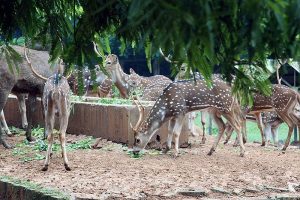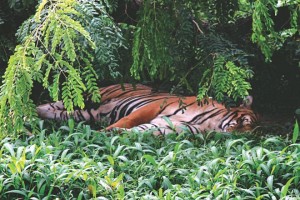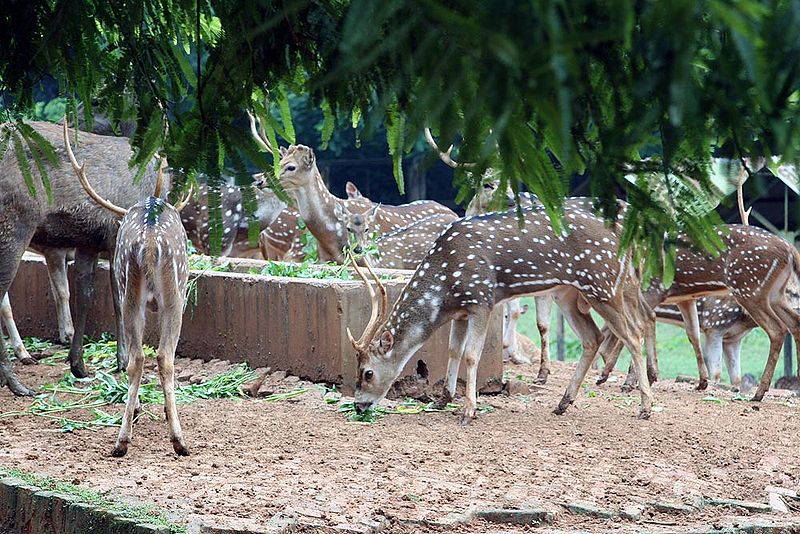Role of zoos in wildlife is very important. KEEPING animals in zoo for public recreation is an age old concept .In the last few centuries many zoos have been established around the world as a refuge for the captured wild animals mainly for giving people pleasure.
However, rather some new zoos are being set up with a view to promoting care of people for wild animals, reproduction of endangered species and increasing the scope of research on wild animals.
Management in zoo
For proper management of wildlife irrespective of captivity or in-situ condition knowledge from three distinct disciplines are very essential — population or community ecology, ethology and systematics.
Food and nutrition: Feeding habit and providing sufficient nutrition are two basic points for selecting food items. Freshness of food is especially important for herbivorous animals. Sufficient amount of fresh water supply also has to be ensured .In zoos of developing countries the staffs of food supply units usually buy substandard food and save money for themselves.
Breeding: In zoo there should be reproductive facilities for most animals excluding only those who do not breed in artificial system. Artificial breeding capacity is one of the major sticking features of modern zoos. When there is sufficient autecological data along with its lifecycle and Ethology for a certain animal it is not impossible to manage its reproductive healthcare. Many animals, most mammals, reproduce naturally in the zoo. Natality and survival of offsprings in a zoo is good indicator of its over all management success.
Treatment: Medical treatment facility is an essential part of the zoo system. Treatment of ailing animals is of great concern for these days’ zoos because incidence rate for certain diseases in captivity is usually higher than in the wild. Usually animals stay in congested and less diverse environment in zoos .This helps develop many density inclined diseases. Experts of veterinary sciences are supposed to be engaged in this sector of zoo management.

Behavior and comfort: Not only meeting the basic needs or survival of animals is the goal of zoo management, animals also have the right to be in comfortable environment. Though some animals group directly oppose the zoo system where they are kept permanently in cages, it is not possible to demolish the system overnight. In zoos animal wellbeing can be ensured in many ways: Making more spacious rooms for them and building their dwelling space in mimicry of their natural habitats are two ways to reduce their pain in absence freedom. Protection from heat and cold, stress and distress and disease causing agents are various measures to increase comfort of animals in zoos.
Exchange: Individual animal has its own genotype. Genetic diversity within the species is very crucial for survival of newborn babies in wild population of vertebrate animals .In the zoo the diversity at species level is very narrow because only a few individuals of a species are kept in a zoo. Animal exchange is important here.
If you exchange animals of a certain species with those in other zoos it will definitely increase the genetic diversity of both animal stocks.
Objectives of zoo
‘Carer’ is the word that can express the role of zoos for the benefits of animals .The word can be elaborated as follows: C =Conservation, A=Animal welfare, R=Recreation, E=Education and R=Research
Conservation: For conservation of wildlife we must ensure — Co-operation; Communication; Co-ordination.
These triple Cs are required among experts from zoology, botany, chemistry and geology. Special contribution is required from taxonomists, ecologists and environmental scientists.
Animal welfare: Rights of animals in a Zoo include feeding, supply of clean water in sufficient quantity and treatment facilities for the sick animals. Animals would be free from — Hunger; Thirst; Malnutrition; Stress and distress; Disease and injury.
Recreation:
Public recreation provided by the zoos gives them a unique scope to teach people about the importance of wild animals for ecological balance of our environment and make them conscious about the adverse impact of anthropogenic activities that promote extinction of animal species.
Education: Education is crucial for conservation .Educating people about significance of wild animals and their presence in nature by various means through their visit zoo to described widely as successful.
Research: In a zoo students of zoology, ecology and conservation biology have many things to learn. Most important field for research in a zoo is adaptation studies of wild animals in an environment different from their native habitat.
Knowledge of wild animal husbandry has increased greatly in recent years, resulting now in the need for populations of many species to be regulated by cooperative zoo efforts. Collective efforts are also re q u i red to exchange accumulated husbandry and reproduction knowledge and experience for species that do not as yet breed optimally in zoos.
Zoos are institutions that can uniquely integrate their three major conservation tasks of environmental education, research, and species and habitat conservation. Combined with the enormous public interest in zoos and the ever more intensive cooperation within the worldwide zoo network, this integrated approach provides a great potential for conservation. The World Zoo Conservation Strategy strongly emphasizes that cooperation, coordination, and interaction in all conservation efforts are the only means for success.
by Mahfujur Rahman
Mahfujur Rahman a graduate in Environmental Sciences, works for Center for Environmental and Geographic Information Services (CEGIS).






